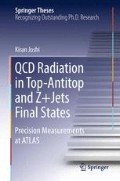Abstract
Muons can be produced in a range of physics processes. Typically those of most interest are muons that originate in the decay of a heavy boson, for example \(W\rightarrow \mu \nu \). Such muons are usually isolated from hadronic activity, in contrast to muons that originate in the decays of hadrons, which are often found within jets. To give us more confidence that muons collected have come from heavy boson decays, as well as reducing the rate of collecting non-isolated and potentially “fake” muons, isolation variables are defined that quantify the amount of hadronic activity surrounding the muon. This chapter describes work performed on commissioning a new isolated muon trigger that uses track information available at the Event Filter (EF). After commissioning, the isolated trigger was used as one of the primary triggers for the 2012 data-taking period.
Access this chapter
Tax calculation will be finalised at checkout
Purchases are for personal use only
Notes
- 1.
In Figs. 4.2, 4.3 and 4.4 the trigger efficiency is measured with respect to offline muons with \(\mathrm {p}_{\mathrm {T}}>20\) GeV and which pass cuts on the quality of their ID tracks. From Fig. 4.5 onwards efficiencies are measured with respect to isolated offline muons that satisfy the same \(\mathrm {p}_{\mathrm {T}}\) and track quality requirements and also have \(\sum \mathrm {p}_{\mathrm {T}}/\mathrm {p}_{\mathrm {T}}(\mu )\) \(<0.1\).
Reference
ATLAS Collaboration. (2012). Performance of the ATLAS muon trigger in 2011 technical report. ATLAS-CONF-2012-099. Geneva: CERN.
Author information
Authors and Affiliations
Corresponding author
Rights and permissions
Copyright information
© 2015 Springer International Publishing Switzerland
About this chapter
Cite this chapter
Joshi, K. (2015). Event-Filter Muon Isolation. In: QCD Radiation in Top-Antitop and Z+Jets Final States. Springer Theses. Springer, Cham. https://doi.org/10.1007/978-3-319-19653-4_4
Download citation
DOI: https://doi.org/10.1007/978-3-319-19653-4_4
Published:
Publisher Name: Springer, Cham
Print ISBN: 978-3-319-19652-7
Online ISBN: 978-3-319-19653-4
eBook Packages: Physics and AstronomyPhysics and Astronomy (R0)

